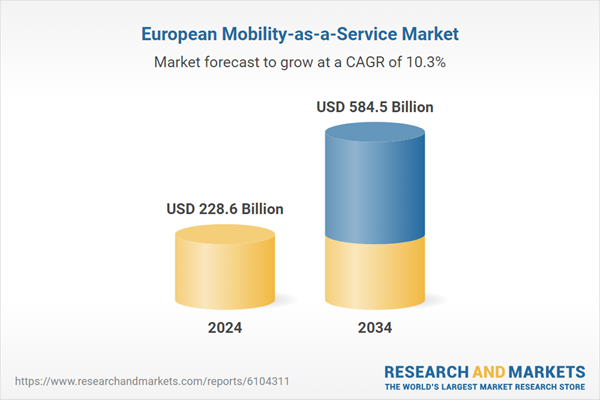Instead of relying on private cars, users are turning to services that bring together ride-hailing, bike-sharing, public transportation, and other travel options under a single interface. The growth of MaaS in Europe is further fueled by the widespread adoption of smartphones and digital applications, which allow for real-time trip planning, e-ticketing, and multi-modal coordination.
As commuters increasingly demand convenience, transparency, and flexibility, digital MaaS platforms are evolving to meet these expectations through features such as cost comparison, live traffic updates, and integrated payment systems. This user-centric model not only enhances accessibility but also encourages environmentally conscious behavior by reducing car dependency and promoting shared mobility.
The market's direction is being shaped by broader digital transformation strategies focused on making cities smarter, cleaner, and more livable. Public authorities across Europe are investing in infrastructure upgrades that support smart mobility ecosystems, with MaaS at the core. Technologies such as artificial intelligence, 5G connectivity, and the Internet of Things are enabling better traffic management and resource allocation, helping MaaS platforms scale across urban regions. In addition to enhancing convenience, these platforms are increasingly viewed as tools for sustainable development, with the capacity to support carbon neutrality and reduce emissions through integrated transport systems.
In terms of service types, the market is segmented into ride-hailing, car sharing, micromobility, bus sharing, and train services. Among these, ride-hailing emerged as the leading segment in 2024, accounting for approximately 33.8% of the total market. It is also anticipated to witness a CAGR exceeding 12.1% from 2025 to 2034. The popularity of ride-hailing stems from its ability to provide flexible, on-demand transport options that are easily accessible via mobile apps. The rising preference for app-based convenience and digital payments continues to drive segment growth.
When categorized by mobile platform, the Europe MaaS market is segmented into Android, iOS, and others. The Android segment led the market in 2024 with a dominant share of 67% and is expected to grow at a CAGR of over 11% during the forecast period. Its widespread use across diverse consumer groups and the affordability of Android devices contribute significantly to its position as the preferred operating system for MaaS applications.
Based on organization size, the market is divided into large enterprises and small & medium-sized enterprises (SME). In 2024, large enterprises held the largest market share at 62%. Their leadership is primarily attributed to their ability to form public-private partnerships, invest in multi-modal infrastructure, and develop solutions that align with mobility regulations and sustainability objectives. These enterprises often work closely with policymakers to deliver MaaS platforms that support low-emission transportation and long-term urban planning goals.
The transportation mode segment is split into public and private systems. In 2024, public transportation held a commanding 64% share of the market. The dominance of public transit can be linked to Europe’s extensive and reliable metro, tram, and bus networks, which remain central to the daily commute of millions. MaaS platforms are designed to enhance the value of public transportation by integrating various services into one ecosystem, thus providing users with a smooth and efficient travel experience.
Regionally, Germany held the highest share of the Western Europe MaaS market in 2024, accounting for around 34.4% of total revenues and generating approximately USD 33.8 billion. The country's advanced digital infrastructure, strong economic position, and progressive mobility strategies continue to support the expansion of MaaS solutions.
Strategic priorities in the Europe MaaS market include the integration of multiple transportation modes into unified digital platforms that provide end-to-end trip planning, centralized payments, and real-time updates. These features not only improve the user journey but also foster increased adoption by making mobility more accessible and reliable. Sustainability also plays a key role, with companies aligning their offerings to environmental goals by incorporating electric vehicles, supporting active transport, and promoting shared mobility to minimize emissions. Additionally, the use of data analytics and artificial intelligence is enhancing personalization, allowing platforms to recommend optimized travel routes and implement dynamic pricing models. These innovations are streamlining urban mobility and contributing to the long-term growth of the MaaS ecosystem in Europe.
Comprehensive Market Analysis and Forecast
- Industry trends, key growth drivers, challenges, future opportunities, and regulatory landscape
- Competitive landscape with Porter’s Five Forces and PESTEL analysis
- Market size, segmentation, and regional forecasts
- In-depth company profiles, business strategies, financial insights, and SWOT analysis
This product will be delivered within 2-4 business days.
Table of Contents
COMPANIES MENTIONED
The companies featured in this europe mobility-as-a-service market report include:- ANI Technologies
- BestMap
- BlaBlaCar
- Citymapper
- Communauto
- Cubic Corporation
- EasyMile
- FOD Mobility
- FreeNow
- Lyft
- MaaS Global
- Moovel Group
- Moovit
- MOTIONTAG
- SkedGo
- Splyt Technologies
- Ubeeqo
- Uber
- UbiGo
- Urbi
Table Information
| Report Attribute | Details |
|---|---|
| No. of Pages | 170 |
| Published | June 2025 |
| Forecast Period | 2024 - 2034 |
| Estimated Market Value ( USD | $ 228.6 Billion |
| Forecasted Market Value ( USD | $ 584.5 Billion |
| Compound Annual Growth Rate | 10.3% |
| Regions Covered | Europe |
| No. of Companies Mentioned | 21 |









